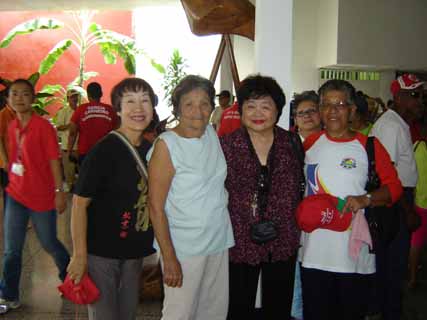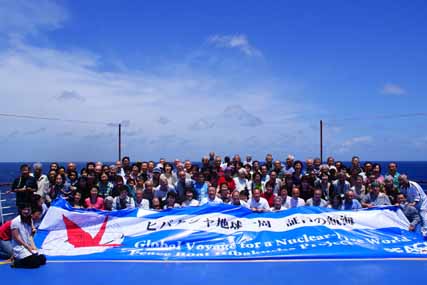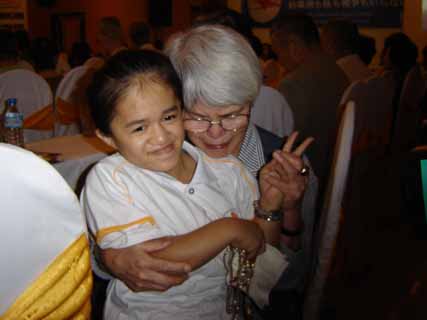The Hibakusha Testimony Project: A Global Voyage for a Nuclear Weapons Free World
Jan. 23, 2009
by Setsuko Thurlow
A-bomb survivors share, learn, and return inspired
On January 13th, Peace Boat finally returned to Tokyo after accomplishing a Global Voyage for a Nuclear Weapons Free World, visiting 20 countries and 23 cities over a period of about four months. The ship carried 103 hibakusha from Hiroshima and Nagasaki ranging in age from their 60s to 80s, some of whom called themselves “Young Hibakusha” who were not yet born in August 1945, or who were too young to remember the events of that time.
The purpose of the voyage was to give the people of as many countries as possible the opportunity to have personal contact with hibakusha, and hear their testimonies. Due to the trusting, worldwide network of NGOs that Peace Boat has developed over 25 years, the large delegation of hibakusha on board the ship, and the additional responsibility assumed by Peace Boat to support Mayors for Peace by having as many mayors as possible sign the Hiroshima-Nagasaki Protocol, local governments, NGOs, and the news media cooperated effectively to welcome Peace Boat, and especially the hibakusha.
The first port of call was Danang, Vietnam. For hibakusha it was a painful encounter with severely deformed children suffering from the genetic effects of Agent Orange. Many hibakusha had uncontrollable tears of empathy, not sympathy, as they embraced the children. Their shock was not only at the sight of the children, but also at the sudden realization that both they and these children were the innocent child victims of the indiscriminate use of weapons of mass destruction. Both acts were committed by the same victimizer who consistently denies responsibility for causing such human suffering.
At the huge celebration for the 35th anniversary of Japan-Vietnam diplomatic relations, the former vice president shared the nation’s deep gratitude for Peace Boat’s consistent aid in the form of medical equipment and supplies to heal the wounds of war. She emphasized her appreciation for the visit by the hibakusha and urged that those who know the effects of war have a special obligation to warn the world of its inhumanity. Later in the voyage, many hibakusha reported that this experience was the most affecting encounter of their entire trip.
After Vietnam, Peace Boat visited Singapore, India, Eritrea, Egypt, Turkey, Greece, Malta, Italy, Spain, Dominican Republic, Venezuela, Panama, Peru, Chile, New Zealand, Australia, and a few islands in the South Pacific. In most countries, the hibakusha were welcomed enthusiastically and they had many opportunities to share their testimonies in city halls, community centers, schools, and churches. This was particularly the case in countries like Greece and Turkey, which have active campaigns against establishing NATO nuclear bases on their territory.
In Barcelona, Spain, on my way to New York as a member of the Peace Boat delegation to the UN General Assembly First Committee (for peace and security), I made an important discovery, namely that the Catalonia Parliament located in Barcelona has a Committee on Peace and Human Rights. The four members of our delegation were invited to this committee where we each presented our testimonies to the elected representatives. In the luncheon and discussion which followed, I was deeply impressed by their depth of understanding and commitment to the ideal of peace and nuclear disarmament. Their own experience of war (the civil war of the 1930s) and the memory of the suffering appeared to make it easier for them to identify with the aspirations of the hibakusha.
Our ten days in New York were crammed full of speaking engagements, press interviews (including the UN Radio), and private meetings with high officials of the UN. The welcome by local groups and individuals, and especially by the Hiroshima and Nagasaki Kenjinkai and the Japanese Ambassador for Disarmament who had traveled from Geneva, Switzerland, was warm and supportive.
With the invitation to give a five-minute official presentation to the UN General Assembly First Committee, I pondered how best to use these precious five minutes, and concluded that my task was to provide the diplomats, especially the younger ones, with a brief immersion into the grotesque death and destruction caused by the atomic bomb. I then added what I considered to be the two most urgent actions to be addressed immediately and acted upon by the UN: to ensure the survival of the NPT and ratification of the CTBT by the U.S. and others. It is gratifying to recall how the large committee room was packed and my speech was met with long, warm applause. Later, the TV crew shooting from the gallery told me that some delegates had tears trickling down their cheeks.
Apart from this presentation, the highlight of my visit to New York was attending the one-day conference of the East West Institute held in the UN building. The conference was opened by Secretary General Ban Ki-moon, followed by Henry Kissinger and other experts in disarmament and security. I could not believe my ears when I heard them echo what hibakusha have been saying these many years. Unlike the tensions of the Cold War period, some panelists advocated drastic reductions in nuclear arsenals, at the very least, and some even suggested total abolition. I was incredibly euphoric.
This hibakusha project by Peace Boat was clearly a historic event. Survivors who had a limited opportunity to view the nuclear weapons issue in a worldwide context have come home feeling enlightened and empowered. They now see that, although nuclear disarmament is a rather remote concern for many people in the world, overshadowed by the immediate problems of poverty and disease, for many others the abolition of nuclear weapons is a global struggle to which they are committed.
Setsuko Thurlow was born in Hiroshima in January 1932. She experienced the atomic bombing at the age of 13, 1.8 kilometers from the hypocenter, while working as a mobilized student. After graduating from Hiroshima Jogakuin University, she studied in the United States. Later, she married a Canadian school teacher and immigrated to Canada. While working as a social worker, she has been involved in peace and anti-nuclear activities. In 2007, she received the Order of Canada, the highest civilian honor in that nation. She currently lives in Toronto.
(Originally published on January 23, 2009)
Related articles
Peace Boat returns to Japan after voyage to the world with A-bomb survivors (Jan. 18, 2009)
Hiroshima mayor hands 370,000 anti-nuke signatures to U.N. (Oct. 30, 2008)
102 A-bomb survivors enroute to 20 countries on Peace Boat (Sept. 9, 2008)
A-bomb survivors share, learn, and return inspired
On January 13th, Peace Boat finally returned to Tokyo after accomplishing a Global Voyage for a Nuclear Weapons Free World, visiting 20 countries and 23 cities over a period of about four months. The ship carried 103 hibakusha from Hiroshima and Nagasaki ranging in age from their 60s to 80s, some of whom called themselves “Young Hibakusha” who were not yet born in August 1945, or who were too young to remember the events of that time.
The purpose of the voyage was to give the people of as many countries as possible the opportunity to have personal contact with hibakusha, and hear their testimonies. Due to the trusting, worldwide network of NGOs that Peace Boat has developed over 25 years, the large delegation of hibakusha on board the ship, and the additional responsibility assumed by Peace Boat to support Mayors for Peace by having as many mayors as possible sign the Hiroshima-Nagasaki Protocol, local governments, NGOs, and the news media cooperated effectively to welcome Peace Boat, and especially the hibakusha.
The first port of call was Danang, Vietnam. For hibakusha it was a painful encounter with severely deformed children suffering from the genetic effects of Agent Orange. Many hibakusha had uncontrollable tears of empathy, not sympathy, as they embraced the children. Their shock was not only at the sight of the children, but also at the sudden realization that both they and these children were the innocent child victims of the indiscriminate use of weapons of mass destruction. Both acts were committed by the same victimizer who consistently denies responsibility for causing such human suffering.
At the huge celebration for the 35th anniversary of Japan-Vietnam diplomatic relations, the former vice president shared the nation’s deep gratitude for Peace Boat’s consistent aid in the form of medical equipment and supplies to heal the wounds of war. She emphasized her appreciation for the visit by the hibakusha and urged that those who know the effects of war have a special obligation to warn the world of its inhumanity. Later in the voyage, many hibakusha reported that this experience was the most affecting encounter of their entire trip.
After Vietnam, Peace Boat visited Singapore, India, Eritrea, Egypt, Turkey, Greece, Malta, Italy, Spain, Dominican Republic, Venezuela, Panama, Peru, Chile, New Zealand, Australia, and a few islands in the South Pacific. In most countries, the hibakusha were welcomed enthusiastically and they had many opportunities to share their testimonies in city halls, community centers, schools, and churches. This was particularly the case in countries like Greece and Turkey, which have active campaigns against establishing NATO nuclear bases on their territory.
In Barcelona, Spain, on my way to New York as a member of the Peace Boat delegation to the UN General Assembly First Committee (for peace and security), I made an important discovery, namely that the Catalonia Parliament located in Barcelona has a Committee on Peace and Human Rights. The four members of our delegation were invited to this committee where we each presented our testimonies to the elected representatives. In the luncheon and discussion which followed, I was deeply impressed by their depth of understanding and commitment to the ideal of peace and nuclear disarmament. Their own experience of war (the civil war of the 1930s) and the memory of the suffering appeared to make it easier for them to identify with the aspirations of the hibakusha.
Our ten days in New York were crammed full of speaking engagements, press interviews (including the UN Radio), and private meetings with high officials of the UN. The welcome by local groups and individuals, and especially by the Hiroshima and Nagasaki Kenjinkai and the Japanese Ambassador for Disarmament who had traveled from Geneva, Switzerland, was warm and supportive.
With the invitation to give a five-minute official presentation to the UN General Assembly First Committee, I pondered how best to use these precious five minutes, and concluded that my task was to provide the diplomats, especially the younger ones, with a brief immersion into the grotesque death and destruction caused by the atomic bomb. I then added what I considered to be the two most urgent actions to be addressed immediately and acted upon by the UN: to ensure the survival of the NPT and ratification of the CTBT by the U.S. and others. It is gratifying to recall how the large committee room was packed and my speech was met with long, warm applause. Later, the TV crew shooting from the gallery told me that some delegates had tears trickling down their cheeks.
Apart from this presentation, the highlight of my visit to New York was attending the one-day conference of the East West Institute held in the UN building. The conference was opened by Secretary General Ban Ki-moon, followed by Henry Kissinger and other experts in disarmament and security. I could not believe my ears when I heard them echo what hibakusha have been saying these many years. Unlike the tensions of the Cold War period, some panelists advocated drastic reductions in nuclear arsenals, at the very least, and some even suggested total abolition. I was incredibly euphoric.
This hibakusha project by Peace Boat was clearly a historic event. Survivors who had a limited opportunity to view the nuclear weapons issue in a worldwide context have come home feeling enlightened and empowered. They now see that, although nuclear disarmament is a rather remote concern for many people in the world, overshadowed by the immediate problems of poverty and disease, for many others the abolition of nuclear weapons is a global struggle to which they are committed.
Setsuko Thurlow was born in Hiroshima in January 1932. She experienced the atomic bombing at the age of 13, 1.8 kilometers from the hypocenter, while working as a mobilized student. After graduating from Hiroshima Jogakuin University, she studied in the United States. Later, she married a Canadian school teacher and immigrated to Canada. While working as a social worker, she has been involved in peace and anti-nuclear activities. In 2007, she received the Order of Canada, the highest civilian honor in that nation. She currently lives in Toronto.
(Originally published on January 23, 2009)
Related articles
Peace Boat returns to Japan after voyage to the world with A-bomb survivors (Jan. 18, 2009)
Hiroshima mayor hands 370,000 anti-nuke signatures to U.N. (Oct. 30, 2008)
102 A-bomb survivors enroute to 20 countries on Peace Boat (Sept. 9, 2008)









